I like the CZ 550 Safari American, even though the folks at CZ Kansas heavy handedly stamp it, stomp it and mischaracterized it as an Americanized version of a European rifle. It’s beefy, an overkill of metal and wood, weighing in at a recoil absorbing 9.25 lbs. It smells like oiled metal and wood, it shoots straight and it feels right when carried, both on and off a sling. It is a rifle that instills confidence.

The 375 H&H cartridge has been doing a good job since 1912; lots of power, flat shooting, flexible bullet weights and types. It takes me back to the days when magnums were big, actions were long and people didn’t hunt the desert and tall pines with rifles and clothes covered in synthetic mossy oak leaves. The ancient days when hunters shaved and showered and didn’t douse themselves in deer pee before going pig hunting, or put on makeup and pretend it was for the purpose of camouflage. My worst hunting companion, in the old days, was a guy who persisted in farting in the vehicle with the heater on and the windows rolled up…but it was easy enough to leave him in the snow at the side of the road. Where was I? Oh yeah… So the only thing wrong with the CZ 550 Safari American is the stock, or at least the stock’s geometry.
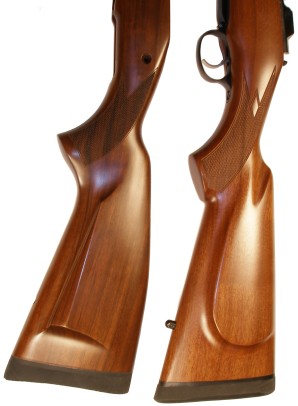 The European version of the C 550 Safari is fitted with a hog’s back stock with Bavarian style cheekpiece and a snabled forend. For those of you who have had your forend snabled, you know how traumatizing that can be. In contrast, the American version has a straight comb with little drop, no cast off and a relatively oval forearm with a rounded forend. Why the difference in cut of wood? Deep in the American psyche is the notion stocks must come straight back at the shooter under recoil. No, I have no idea why, but then I have never tried to seal a gunshot wound with a hot knife blade, or attempt my own dental work, or put on a hamburger suit before feeding a pit bull. Simply put, I don’t like rifles that smack the snot out of me, which is not the same as saying I don’t like rifles that are chambered for heavy rounds, or produce lots of recoil. It isn’t the amount of recoil, it is how the recoil is managed and directed by the firearm and shooter combination.
The European version of the C 550 Safari is fitted with a hog’s back stock with Bavarian style cheekpiece and a snabled forend. For those of you who have had your forend snabled, you know how traumatizing that can be. In contrast, the American version has a straight comb with little drop, no cast off and a relatively oval forearm with a rounded forend. Why the difference in cut of wood? Deep in the American psyche is the notion stocks must come straight back at the shooter under recoil. No, I have no idea why, but then I have never tried to seal a gunshot wound with a hot knife blade, or attempt my own dental work, or put on a hamburger suit before feeding a pit bull. Simply put, I don’t like rifles that smack the snot out of me, which is not the same as saying I don’t like rifles that are chambered for heavy rounds, or produce lots of recoil. It isn’t the amount of recoil, it is how the recoil is managed and directed by the firearm and shooter combination.
If you’ve fired a heavy recoiling firearm with a hog’s back stock, or a Weatherby stock, you’ve probably noticed the cheekpiece works well with low to medium height scope mounts, metallic sights and the forends, while comparatively slender, makes for a better hold. On discharge, 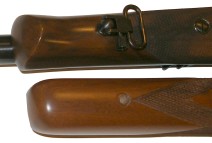 the muzzle of these firearms tends to rotate upward and pull the cheek piece away from the shooter’s face. Shoot from the bench with an “American style” stock and you get punched in the shoulder and smacked in the face. Subsequently, with this knowledge tattooed on my shoulder, when I bought my CZ Safari American, I also bought a replacement European style stock. At around $200, it has to be the least expensive piece of nice Turkish Walnut I’ve ever purchased, especially since it was a factory “drop in” fit. That doesn’t sound right, an action drops in, the stock catches it… Let’s say fully inletted factory stock.
the muzzle of these firearms tends to rotate upward and pull the cheek piece away from the shooter’s face. Shoot from the bench with an “American style” stock and you get punched in the shoulder and smacked in the face. Subsequently, with this knowledge tattooed on my shoulder, when I bought my CZ Safari American, I also bought a replacement European style stock. At around $200, it has to be the least expensive piece of nice Turkish Walnut I’ve ever purchased, especially since it was a factory “drop in” fit. That doesn’t sound right, an action drops in, the stock catches it… Let’s say fully inletted factory stock.
It fit like a four fingered glove with two thumbs…
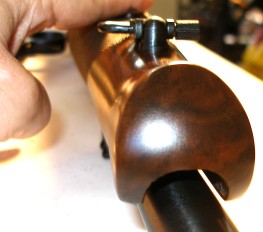
CZ did a great packaging the replacement stock. It came with sling buttons, a forearm fastener bushing made to an appropriate contour, a quality Decelerator recoil pad, clean cut checkering, nice grain, and fully finished and sealed inside and out. When I attempted to drop the action into the new stock, unfortunately, the recoil lug hit the lug bearing surface on the barrel, leaving a 1/2″ gap between the barrel and forend. Just a tad more gap than useful, even for a floater.
Normally, this is where I put away all of my tools, pack up the problem and ship it off to someone who knows that they are doing for repair. However, this bump in the road was standing between me and working on a larger project so it was time to work with sharp tools.
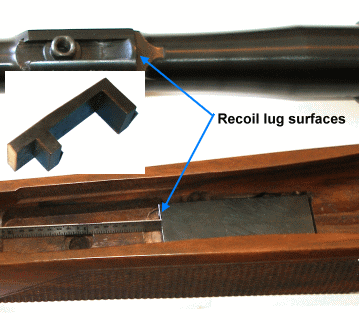 The primary culprit in the misfit of things was at the recoil lug. The recoil lug, see inset, looks like a slack jawed capital “F”. Oriented as pictured, it rides in a recess in the barrel channel comprised of a flat and two cross grooves. The first problem was that the impact face of the lug protruded too far, and would not clear the recoil surface of the barrel to permit seating in the stock; see arrows. Rather than try to manage a tricky cut on the cross slots in the stock, I opted to face the lug and remove approximately 0.020″ for adequate clearance. Once clear, the barrel dropped and reduced the gap at the forend to 1/4″. Better, but still pretty lousy as fit goes.
The primary culprit in the misfit of things was at the recoil lug. The recoil lug, see inset, looks like a slack jawed capital “F”. Oriented as pictured, it rides in a recess in the barrel channel comprised of a flat and two cross grooves. The first problem was that the impact face of the lug protruded too far, and would not clear the recoil surface of the barrel to permit seating in the stock; see arrows. Rather than try to manage a tricky cut on the cross slots in the stock, I opted to face the lug and remove approximately 0.020″ for adequate clearance. Once clear, the barrel dropped and reduced the gap at the forend to 1/4″. Better, but still pretty lousy as fit goes.

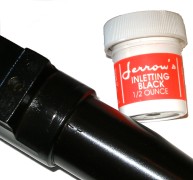
I blackened the lower metal surfaces and the underside of the recoil lug, stippling with the tip of a small stiff brush, moderately tightened the guard and forearm fasteners, and checked for uniformity of contact. Jerrow’s is pretty good stuff. It transfers cleanly and wipes off…except from your hands, which takes a little longer. Brownells carries it in black and gold colors. Pictured left, the lug was supported in the channel, but contact was minimal except for the leading edge where it was bring pressured directly by barrel pressure. Only the inletting for the action’s tang sawq any contact; there were no indication of support or contact for the action or barrel and the lower edge of the ejection port rose at an angle from the stock. Hmmm…
 The tool marks in the forearm wood looked ball shaped rather than planner and the overall surface looked cupped. So I thought getting that surface in shape first was the best approach. I am at that point in my life where I know what I am, and what I am not. I are not a craftsman, particularly that rare breed that can start with a plank of wood and end up with a aesthetically pleasing or close tolerance three dimensional shape. However, I do have a Bosch Colt, Palm Grip trim router that is bigger than a Dremel, but smaller than big router that could turn the stock into kindling. I taped the sides of the barrel channel to prevent marring, cranked up a 1/4″ spiral double flute bit and began shaving off hundred’s of an inch at a time; can’t put it back on, once it is removed.
The tool marks in the forearm wood looked ball shaped rather than planner and the overall surface looked cupped. So I thought getting that surface in shape first was the best approach. I am at that point in my life where I know what I am, and what I am not. I are not a craftsman, particularly that rare breed that can start with a plank of wood and end up with a aesthetically pleasing or close tolerance three dimensional shape. However, I do have a Bosch Colt, Palm Grip trim router that is bigger than a Dremel, but smaller than big router that could turn the stock into kindling. I taped the sides of the barrel channel to prevent marring, cranked up a 1/4″ spiral double flute bit and began shaving off hundred’s of an inch at a time; can’t put it back on, once it is removed.

During the whole process the stock was anchored by a large wood vise, barely tightened to avoid cracking the stock or flattening the checkering. After the first cut another trial fit with inletting black suggested to me that I was on the right track. Patience is not one of my virtues, but the increment of material removal was dropping the bit to the newly cut surface and locking it in place. The cut edge could barely be picked up by scraping with a finger nail. I believe I had to make about 5 or 6 cuts to get ball park and, after each cut, I had to check the bottom of the recoil lug legs to ensure they weren’t bottoming in the stock, and I had to check for contact in the barrel channel and around the action. I wanted a close fit, but I wanted a floating barrel and I didn’t want to have to use glass bed to finish the job.
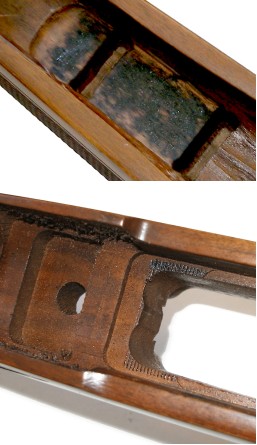
About 1/16″ down, I had to clear the bottom of the cross channel to regain clearance for the recoil lug legs. The bottom of the cross slots are not a contact surface so I clearanced with a ball file mouted to a Dremel flex shaft. At this point the recoil lug to stock contact became relatively uniform and the lug to stock fit was tight. I figured, if the lug was loose, fore and aft, the stock would take a pounding under repeated recoil and perhaps become damaged. If I break this stock, I will definitely glass bed the lug on the next effort. With the recoil lug surfaces flat and in full contact, the barrel came down properly and in alignment with the barrel channel. The action made contact at all four corner contact points and the ejection port opening was parallel to the cut out in the stock. Again, there was no contact in the barrel channel outside of the support received from the recoil lug, so I was pretty much where I wanted to be. I cleaned up the inletting black, and sealed the worked area with Minwax sanding sealer to minimize water absorption and reassembled the rifle.
The torque used for the initial guard and forearm fasteners was 30 in/lbs, which seemed to pull everything into place. I used LocTite Blue to keep the fasteners from vibrating loose, while allowing removal with regular hand tools and no special handling. The factory has torqued the American stock forearm to over 40 ft/lbs, something I found uncesessary.
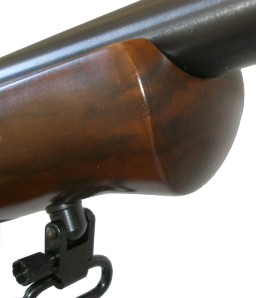
I don’t believe I will be winning any awards for stock making, but I think this is a far better fit than the original. Three shot groups were tight and there were no stringers, flyers, or “Is that my shot on your target?” range wandering.
The stock came with a cross bolt, or at least a stress bolt, that feeds across, just forward of the small of the stock. I do not know its functional effectiveness, but it does look nice, and all of these parts were also in the box with the stock. It all really changed the personality of the rifle, both appearance and shooting. For a 375 H&H gun, the recoil seems relatively mild and it is very steady on target, even in off hand hold. The Decelerator pad is a welcome addition. It tends to keep the scope’s ocular off my nose under recoil. It was interesting to shoot, side by side, with a Ruger Hawkeye African chambered for the 375 Ruger. Now that the CZ looks like a real safari rifle, more to follow.
Before and after…


Get The Big Gun…and call me Bwana Part I
Get The Big Gun…and call me Bwana Part II
Get The Big Gun…and call me Bwana Part III
Thanks,
Joe

Email Notification